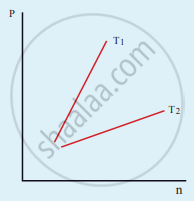Advertisements
Advertisements
प्रश्न
Estimate the total number of air molecules in a room of a capacity of 25 m3 at a temperature of 27°C.
उत्तर
T = 27°C + 273 = 300 K
kB = 1.38 × 10−23 J K−1
V = 25 m3
As Boltzmann’s Constant, kB = `"R"/"N"` ⇒ R = kBN
Now, PV = nRT = nkBNT
The number of molecules in the room,
nN = `"PV"/("k"_"B""T") = (1.013 xx 10^5 xx 25)/(1.38 xx 10^-23 xx 300)`
= `(25.325 xx 10^5)/(414 xx 10^-23)`
= 0.06117 × 1028
= 6.117 × 1026 molecules
nN = 6.1 × 1026 molecules
APPEARS IN
संबंधित प्रश्न
The ratio γ = `"C"_"p"/"C"_"v"` for a gas mixture consisting of 8 g of helium and 16 g of oxygen is ____________.
The following graph represents the pressure versus number density for an ideal gas at two different temperatures T1 and T2. The graph implies

What is the microscopic origin of pressure?
If 1020 oxygen molecules per second strike 4 cm2 of wall at an angle of 30° with the normal when moving at a speed of 2 × 103 ms−1, find the pressure exerted on the wall. (mass of one oxygen atom = 2.67 × 10−26 kg)
According to the assumptions made in the kinetic theory of gases, when two molecules of a gas collide with each other, then ______.
The average force applied on the walls of a closed container depends as 'Tx', where 'T' is the temperature of an ideal gas. The value of 'x' is ______.
What is an ideal gas?
Does an ideal gas exist in practice?
The kinetic energy per molecule of a gas at temperature T is ______.
The velocities of five molecules are 2 m/s, 3 m/s, 4 m/s, 5 m/s and 6 m/s. Find the root mean square velocity of molecules.
